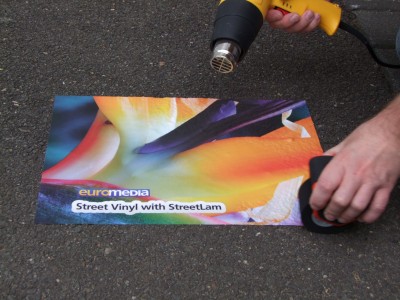Key considerations
Knowing which applications will be printed is just the beginning, as there are many other differences between printers to consider before buying one.
One of the key considerations is the flexibility of output. A hybrid machine can handle both flatbed and roll-to-roll printing, but the sign shop needs to determine whether not doing so will be realistic. In many cases, a single printer is instead dedicated to one task.

A large-format digital inkjet printer can create many specialty products, including outdoor street graphics.
The roll or flatbed size should be matched to the sign shop’s common output sizes, while also checking substrates are available in the specified format. Limiting width will help minimize waste of consumables. With a flatbed printer, zoning and vacuums can also reduce setup time.
Another factor for efficiency and cost is labour automation. Many of today’s large-format inkjet printer workflows are designed to integrate or reduce the number of production steps, along with post-print finishing. As a result, a single operator can now drive multiple devices.
The quality of output will also vary by printer, including outdoor durability, clear viewing distances and environmental factors like offgassing of solvents. It is important to check the actual quality of a printer’s graphics and not simply trust marketing hype.
Similarly, speed is a major consideration in today’s competitive market. Before buying a printer, it is important to calculate its real output production in square metres per hour with the necessary substrate size and image quality. Maintenance requirements will also come into play, as downtime will affect overall speed.
Ink adhesion and durability should be checked on the chosen substrates. Some inks offer a greater colour range than others, but given the associated costs of complicated configurations—including purging inkjets—it is best to buy the least number of colours needed to do the job. And if a shop is comparing original equipment manufacturer (OEM) and aftermarket inks, it will be important to test both options.
A time of change
Canadian PSPs and signmakers are leading the charge in acquiring and using new wide-format printing devices. Most screenprinting companies in Canada, for example, have already adopted digital technologies. Those who still have screen equipment are, for the most part, shutting down those parts of their business. Year-over-year growth continues to be very strong at the industrial wide-format level.
Traditional commercial printing companies are entering this marketplace as part of their diversification strategies, so competition is growing with sign shops, traditional screenprinters and POP display providers. This competition is hurting profit margins, which is why shops are looking to increased automation and other ways to reduce their costs.
Tony Karg is Fujifilm Canada’s senior director of corporate communications and marketing for graphics systems, based in Mississauga, Ont. For more information, contact him via e-mail at tkarg@fujifilm.com.





